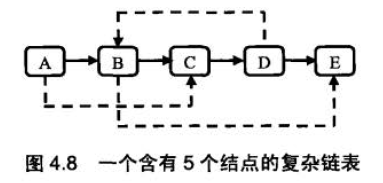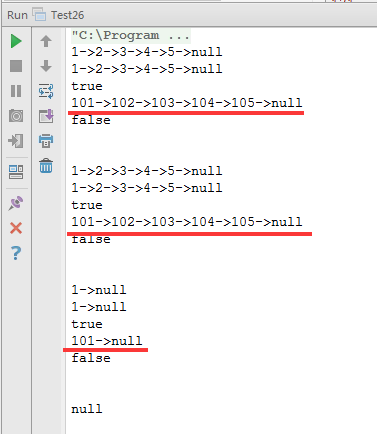【劍指Offer學習】【面試題26:複雜連結串列的複製】
阿新 • • 發佈:2018-12-31
題目:請實現函式ComplexListNode clone(ComplexListNode head),複製一個複雜連結串列。在複雜連結串列中,每個結點除了有一個next 域指向下一個結點外,還有一個sibling 指向連結串列中的任意結點或者null。
結點結構定義:
public static class ComplexListNode {
int value;
ComplexListNode next;
ComplexListNode sibling;
}解題思路:
圖4.8 是一個含有5 個結點的複雜連結串列。圖中實線箭頭表示next 指標,虛線箭頭表示sibling 指標。為簡單起見,指向null 的指標沒有畫出。
在不用輔助空間的情況下實現O(n)的時間效率。
第一步:仍然是根據原始連結串列的每個結點N 建立對應的N’。把N’連結在N的後面。圖4.8 的連結串列經過這一步之後的結構,如圖4.9 所示。
第二步:設定複製出來的結點的sibling。假設原始連結串列上的N的sibling指向結點S,那麼其對應複製出來的N’是N的pext指向的結點,同樣S’也是S的next指向的結點。設定sibling之後的連結串列如圖4.10 所示。
第三步:把這個長連結串列拆分成兩個連結串列。把奇數位置的結點用next .
連結起來就是原始連結串列,把偶數位置的結點用next 連結起來就是複製
出來的連結串列。圖4. 10 中的連結串列拆分之後的兩個連結串列如圖4.11 所示。
程式碼實現:
public class Test26 {
/**
* 複雜連結串列結點
*/
public static class ComplexListNode {
int value;
ComplexListNode next;
ComplexListNode sibling;
}
/**
* 實現函覆制一個複雜連結串列。在複雜連結串列中,每個結點除了有一個next欄位指向下一個結點外,
* 還有一個sibling欄位指向連結串列中的任意結點或者NULL
*
* @param head 連結串列表頭結點
* @return 複製結點的頭結點
*/ 執行結果:
注意:劃紅線部分是為了區分原連結串列和複製連結串列,具體還原見程式碼註釋。





